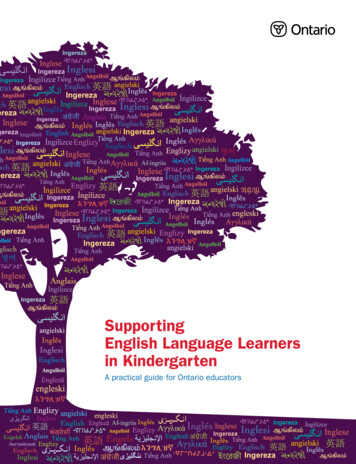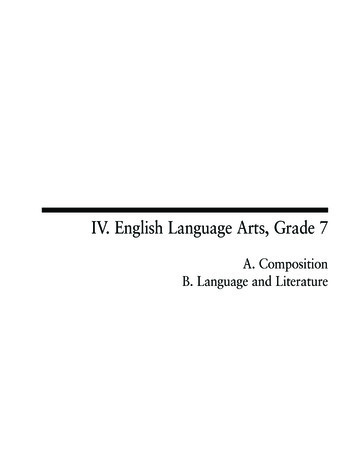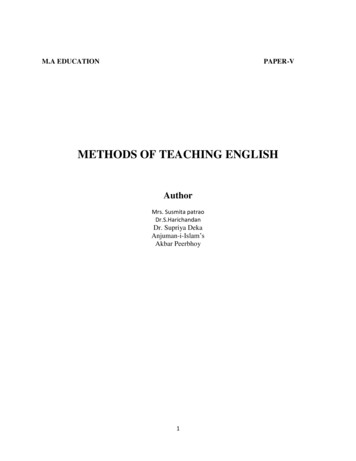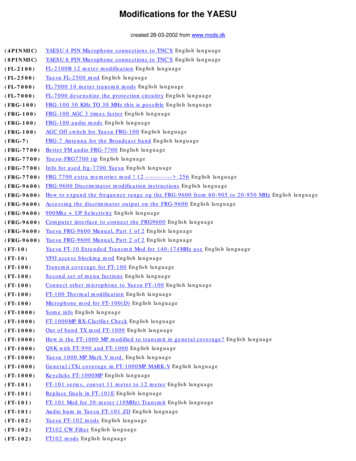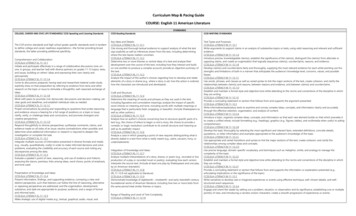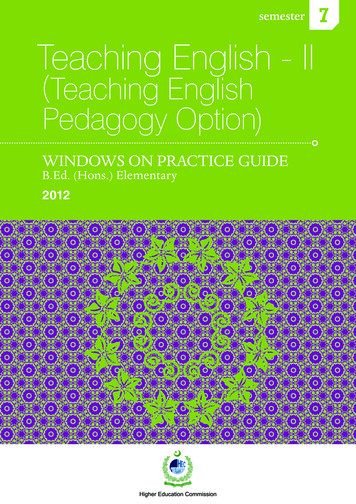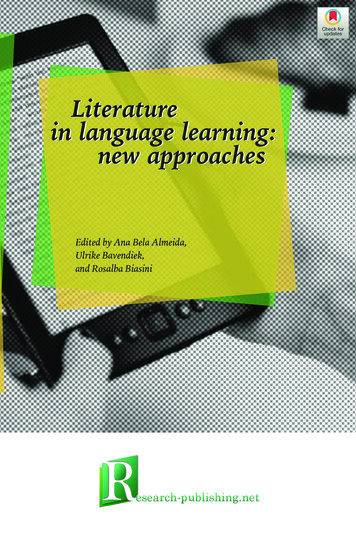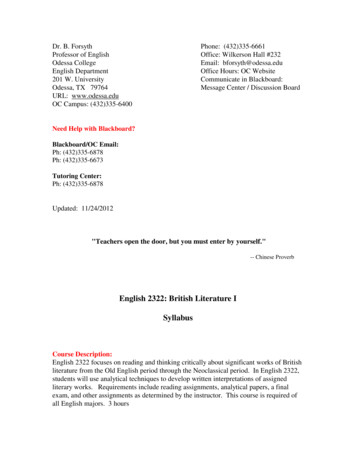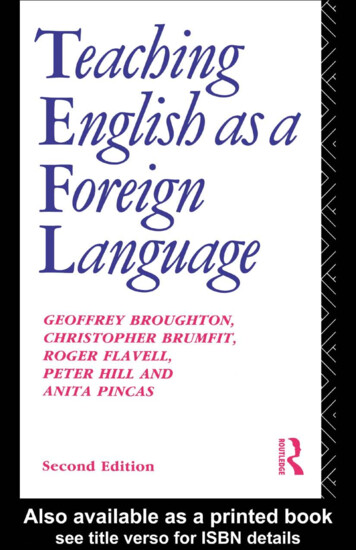
Transcription
English Language Teaching; Vol. 7, No. 3; 2014ISSN 1916-4742E-ISSN 1916-4750Published by Canadian Center of Science and EducationLiterature and English Language Teaching and Learning: A SymbioticRelationshipRichard C. Ihejirika11Directorate of General Sutdies, Federal University of Technology, Owerri, NigeriaCorrespondence: Richard C. Ihejirika, Directorate of General Sutdies, Federal University of Technology, Owerri,Nigeria. Tel: 80-3376-4807. E-mail: richihejirika@yahoo.comReceived: November 4, 2013doi:10.5539/elt.v7n3p85Accepted: January 9, 2014Online Published: February 12, 2014URL: http://dx.doi.org/10.5539/elt.v7n3p85AbstractA close look at literature and language shows that the two are closely related. This close relationship is obviousbecause from all indications, literature presupposes language. It is inconceivable to discuss literature withoutreference to language. But going by the traditional practice at the secondary school level in Nigerian context,there are indications that Literature and English Language are treated as two separate school subjects. At thesenior secondary school level, the subjects are taught in different classroom settings by teachers that are eitherdesignated Literature teachers or English teachers. By this dichotomy, the Literature teachers, to a large extent,pre-occupy their teaching period with the teaching of the stories, the contents and the socio-cultural, economicand religious implications of the prescribed literary texts without placing much emphasis on the languagecomponents of the texts. In the end, some students have been found to have done very well in the Literatureexams but perform poorly in English Language. Against this background, this paper posited that the relationshipbetween literature and language is symbiotic. It was, therefore, suggested that the relationship should beexplored and exploited in order to enhance effective teaching and learning of Literature and English Language atthe secondary school level so that the learners would possess high level of proficiency in the use of EnglishLanguage, which would ultimately contribute immensely in addressing the seeming poor academic performanceat the secondary and tertiary levels of education in Nigeria. Some suggestions for effective teaching and learningof Literature and English Language were made.Keywords: literature, English language, language teaching and learning, symbiotic relationship1. IntroductionThe significant role of English Language in the linguistic, educational, socio-economic and cultural settings ofNigeria is not in doubt. In the field of education in particular, English Language plays a dominant role. As thelanguage for education and by extension the target language, the success or failure of formal education, to a largeextent, depends on the level of competence of learners in English Language in schools and colleges.Unfortunately, in contemporary time, “available evidence in the way our students use English in our schools andcolleges shows that their English Language competence and English Language awareness leave much to bedesired” (Onukaogu, 2002, p. 300). For instance, it is common knowledge that a good number of secondaryschool leavers and tertiary institution graduates hardly express themselves fluently in both spoken and writtenEnglish, and this anomaly has been found to be partly responsible for the poor academic performance threateningall levels of education in Nigeria.As to what is typically responsible for the poor performance in English language among students, myriad ofreasons have been advanced by scholars. For instance, Ubahakwe (1988) identifies a couple of factors whichamong other things include the educational setting, the educational system, teachers’ status and motivation, theexamination pattern, the learning environment, teacher preparation and language philosophy. Ayodele (1988)states that the causes of the abysmal performance in English Language must be traced to the classroom because“the formal classroom practices provide by far the greatest avenue for the learning of the language”. Babatunde(2002, p. 130) identifies the classroom factors to include: “teachers’ low level of competence in the languageskills, especially reading; unduly large classroom; too many periods per week; lack of incentive; and learners’unserious attitude” among others. Another classroom factor threatening effective acquisition of EnglishLanguage is the method of teaching Literature which separates it from English Language. By this method,85
www.ccsenet.org/eltEnglish Language TeachingVol. 7, No. 3; 2014Literature classroom is different from that of English Language. Consequently, the resources of Literature, whichhave the potentialities of enhancing effective language learning, are denied the learners. This practice, no doubt,could be said to have inhibited effective teaching and learning of Literature and English Language in our schoolsand colleges. No wonder a good number of Nigerian secondary school students hardly express themselvessufficiently in English even after they had offered Literature and had a good grade in it.In the light of the foregoing, the thrust of this paper is to establish the fact that there is a symbiotic relationshipbetween literature and language; and further demonstrate how Literature could be integrated with EnglishLanguage teaching and learning in an ESL setting for effective result.2. The Concept and Functions of LiteratureThe term “literature” is used basically in two different senses. First, it is used to refer to any written material on asubject. Second, it is a term used to refer to one of the school subjects studied by students or a universitydiscipline; and it is this second sense that applies to us in this context. As a subject or discipline, Literature hasbeen variously defined by different scholars. According to Onuekwusi (2013, p. 5), “Literature is anyimaginative and beautiful creation in words whether oral or written, which explores man as he struggles tosurvive in his existential position and which provides entertainment, information, education and excitement to itsaudience”. Although the definition of Literature by Onuekwusi succinctly attempts to capture the essence ofliterature, it is pertinent to point out that not all literature is imaginative. As a matter of fact, some literary worksare factual, and it is based on this understanding that the prose genre is classified into two, namely fiction andnon-fiction. A good example of a popular non-fictional literary work is Zambia Shall be Free written byKenneth Kaunda. But be that as it may, the basic element in Literature that is indispensable that can be deducedfrom the definition under reference is the fact that Literature, no matter the type or genre, is written in words.This is to say that language is the basic raw material with which literature is manufactured. It is based on thisview that it is usually said that “Literature is language in practice”. That is to say that language theories, conceptsand styles are put into function in the creation of literary texts. Therefore, if one must interpret and analysis aliterary text, one must be competent in the language of the text and conversely if one must be competent inlanguage, one should be sufficiently exposed to the literature of the language in question.As a school subject, there are some significant functions Literature performs. Put differently, the whole essenceof developing Literature as a school subject is for the students to derive some benefits. Ayo (2003, p. 128)describes the benefits as the general utilities of Literature. According to him, “the utilities of Literature could beeducational, cultural, moral, recreational and socio-political. Literature helps to develop the learner’s linguisticperformance because it arouses their zeal and keeps in them an ever-ready inclination to read. Moreover, it helpsthe learners to develop fluency and the ability to comprehend what is read”. Collie and Slater (1987) support theinclusion of Literature in the language classroom because it provides valuable authentic material, developspersonal involvement and help contribute to readers’ cultural as well as language enrichment. Still on the utilitiesof Literature, Lazar (1993, pp. 15-19) provides five reasons for using literature in ELT to include:1) Motivating materials2) Encouraging language acquisition3) Expanding students’ language awareness4) Developing students’ interpretative abilities5) Educating the whole person.Adding his voice to the utilities of Literature as a school subject, Unoh (1981) quoted in Ogunnaike (2002) positsthat a good literature can be an important aid to cultural assimilation or acculturation; language development andcompetence; conflict resolution; emotional development and stability; development of positive and good-orientedattitudes to life; a good liberal education, entertainment, relaxation and the sharing of vicarious experiences ofpositive value; the development of desired and desirable moral or other attributes; and as a consequence of all these,a stable and mature personality.3. The Symbiotic Relationship between Literature and LanguageLiterature and language are not only intertwined but also inter-related. Literature pre-supposes language because itis with the instrument of language that Literature is concretized. Therefore, it sounds absurd to study Literaturewithout language at the centre stage or to study language without Literature playing a prominent role. It is based onthis view that the relationship between Literature and language is best described as symbiotic. The symbioticrelationship between Literature and language is summed up in the words of Willmott (1979, p. 57):86
www.ccsenet.org/eltEnglish Language TeachingVol. 7, No. 3; 2014A work of literature for all reading ages—is an organisation of language to which linguistic awareness must beapplied if it is to understood and appreciated. In the process the pupil learns much of practical value both aboutlanguage and in the use of language. In his literary studies he meets language in its most varied and powerful forms,and learns to examine the writer’s use of it in the context of all the linguistic resources available to him. Thus,literature demonstrates language at work. But it also helps the pupil to use language; it offers good models andstimulates linguistic responses of various kinds. English teachers not only present literature; they also exploit it,because it can generate language as well as exemplify it.Literature is rooted in language and language gets life through Literature. So Literature and language are closelyinterconnected. According to Lazar (1993), Literature should be used with students because it is a motivatingstimulus for language acquisition, students enjoy it, and it is a fun, it is found in many syllabuses and the like.Literature, a convenient source of content for a course in foreign language, provides motivating materials forlanguage teaching. Carter and Long (1991) equally agree that Literature is a legitimate and valuable resource forlanguage teaching.Valdes (1986) opines that it is simply accepted as given that Literature is a viable component of second languageprograms at the appropriate level and that one of the major functions of Literature is to serve as a medium totransmit the culture of the people who speak the language in which it is written. When we use Literature inlanguage classroom, we are teaching language. Literature is a high point of language usage; arguably it marks thegreatest skills a language user can demonstrate. Anyone who wants to acquire profound knowledge of languagethat goes beyond the utilitarian will read literary texts in that language (Basnett & Grundy, 1993).Still on the relationship between Literature and language, Udor and Ubahakwe (1979) quoting Brooks (1966) alsosay that English and Literature are interrelated and therefore support that the study of English Language andLiterature should be integrated, since the latter is wholly and inevitably rooted in the former. They argue that sincethere could be no dichotomy between a father and a son, so there is no sharp demarcation between language andLiterature because Literature presupposes language. In the same vein, Ayo (2003, p. 130) is of the opinion that“through the creative methods of teaching Literature, the students can be helped to develop confidence inthemselves in producing coherent and cohesive spoken discourses and in organizing sentences into paragraphswith effective linkers and organizing paragraphs into coherent and meaningful written discourse”.Besides, the study of Literature particularly enhances the development of extensive reading skills. Researchfindings are overwhelmingly in support of the fact that there is correlation between extensive reading and languageacquisition, especially effective writing. For instance, Wilkins (1978) posits that reading can provide a readymeans for the acquisition of vocabulary and effective writing in a second language. The source further states thatreading brings to the reach of the learner large repertoires of lexical items in their natural linguistic contexts.Wilkins’ argument that reading facilitates acquisition of vocabulary is very much strong because the hallmark ofany effective writing is ability to use appropriate words to form meaningful sentences that are logically andsequentially linked. Thus, all efforts to write would come to naught if the writer does not have a good commandof the vocabulary of the target language. Guth and Schuster (1997, p. 75) agree with the proponents of thereading-writing relationship theory by insisting that: “The good writer is a good reader”. Explaining the role ofreading in the ability to write well, the source contends that:In our writing, we draw first of all from our own experience. But our personal experience is limited. Most of ushave little chance of becoming world travel or explorers of spaces. Not everyone can become a recognizedexpert in some branch of science or a brilliant analyst of foreign affairs. But all of us can share in suchknowledge and have taken the time to set it down for us in books and magazines.To further throw more light to the reading-writing relationship, Guth and Schuster (1997) outlines three waysreading positively impacts on writing:1) Reading broadens the students’ familiarity with the resources of language.2) Reading provides information useful in their own.3) Reading enables students to compare their own experiences with those of others.Phelps-Teraski, Phelps-Gunn, and Stetson (1983) while commenting on how reading activities relate to writingimprovement contends that like speech, reading has an important place in language development, even withwriting. According to the source, reading increases exposure to sentence construction, vocabulary, ideas andlanguage fluency and also helps students develop their own idea as well as become familiar or fluent withsemantic and syntactic structures. The source equally insists that reading can provide models of expression thatthe reader may like and wish to imitate.87
www.ccsenet.org/eltEnglish Language TeachingVol. 7, No. 3; 2014Krashen (1984, 1985, 1987) liken the relationship between reading and writing to that between a mother and herbaby. The sources posit that good writing is the by-product of vast and leisure reading and that good writers havedone more reading for their own interests and pleasure than poor writers. The sources conclude that writingcompetence comes only from large amounts of self-motivated reading for pleasure and/or interest. Krashen’sargument is significant in two respects. First, the author identifies extensive reading which literature hones as themode of reading that actually influences writing. Second, Krashen made us to understand that it is large amountsof self motivated reading for pleasure that would give rise to the desired effect on writing.Omojiuwa (1997) agrees that reading and writing skills are actually closely related and could most often beregarded as one unified skill with reading acting as a stimulant for writing and vice versa. The author contendsthat people read in order to obtain information, develop vocabulary, make inferences, classify, observe, analyse,criticise, identify relationships, differentiate styles, draw conclusion and make generalizations.Ayo (2003) argues that through prose teaching, the skills of intensive and extensive reading as well as skimmingand scanning can be developed. According to Ayo, if the students reading efficiency is enhanced, their writing skillwill also be improved because to be a good writer one has to be a good reader. Ayo also contends that proseliterature can be used to increase students’ vocabulary and thereby facilitate their writing ability; and the ability tohave intelligible discussion of the essential parts of a novel can aid students’ mastery of some basic forms ofwriting, for example, argument, description, narration and exposition.From the foregoing, it is crystal clear that reading, which is a characteristic feature of Literature, enhanceslanguage acquisition in general and effective writing in particular. But going by the abysmal poor performance ofstudents in English at all levels of education in contemporary time, it would appear that the resources of Literaturethat facilitate language acquisition have not been fully harnessed, especially at the secondary school level becauseof the current method of teaching Literature at that level. It is common knowledge that Literature at the secondaryschool level is taught as a separate subject different from English. Going by this method, while some teachers aredesignated Literature teachers others are classified as English teachers. By this arrangement, the business ofLiterature teachers is to strictly teach Literature without reference to the language components while Englishteachers do the same on the part of English Language without reference to literature. In all, there is no synergy orteaching cooperation between the two classes of teachers since everyone of them is on their own. It is our thinkingin this paper that this traditional method should be reviewed in order to pave way for an innovation that wouldcreate room for the exploration and exploitation of the symbiotic relationship between Literature and language inorder to enhance proficiency in the use of English Language among learners of English as a second language.4. Suggestions for Teaching Literature and English for Effective ResultIn this section of the paper, it is our intention to outline some suggestions for teaching Literature and EnglishLanguage for effective result.1) The Literature and the English Language teachers should be made to have a common goal of promotingefficiency in the use of English in their professional assignment. In order to achieve this goal, their professionaltraining should be designed in such a way that they would be competent in both Literature and English Languageso that the Literature teacher should possess all the basic skills necessary for teaching language while the EnglishLanguage teacher should also be competent enough to teach Literature. The practice whereby teacher A claims hespecialises in teaching Literature while teacher B is an expert in English Language should be de-empahsised. In theclassroom setting, their teaching should compliment each other’s effort. The Literature teacher should not close hiseyes to the language hints that abound in the prescribed literary texts while the language teacher should not hesitateto use excerpts from the prescribed literary texts to illustrate his teaching of various language components. By thisapproach, the success or failure of the learners in English Language in the classroom should be a collectiveresponsibility of both the language and Literature teacher and not exclusively that of the language teacher as it isthe case in the present time.2) The importance attached to English language and Mathematics should be extended to Literature at thesecondary school level. At the junior secondary school it should be taught and learnt as a fully-fledged subject andnot a component of English language where it is given a scanty coverage. When taught as a separate subject at thejunior secondary school level, there would be an ample opportunity for the learners to be exposed to severalliterary texts at that impressionistic stage, which would in turn encourage the learners to cultivate the habit ofreading extensively. At the senior secondary school level, Literature should be made a core subject as English andMathematics and made compulsory for all students irrespective of one’s area of inclination. This practice wouldenable all students passing through secondary school to benefit from the resources of Literature which areexpected to enhance their proficiency in English.88
www.ccsenet.org/eltEnglish Language TeachingVol. 7, No. 3; 20143) A situation whereby students are required to read only the few literary books prescribed by the examinationbodies for Literature does not create room for the students to imbibe the culture of extensive reading, whichresearch findings have found to be one of the potent ways of addressing lack of proficiency in English. Thestudents at both the junior and the senior secondary school should be made to read appreciable number of literarytexts as it would create room for the learners to be immersed in the target language, which would in turn boost theirproficiency in English.4) The examination bodies should desist from the practice whereby language blemishes are not penalized inLiterature exams. The practice whereby language errors are not put into consideration in assessing candidates inLiterature exams vitiates the significance of Literature in the acquisition of language. The reason is that theteachers as well as the learners of Literature would be complacent about language component of Literature sincethey know that one can end up with an excellent grade in a Literature exam without being proficient in Englishlanguage.5) Literature should be allotted a reasonable number of periods on the school time table as in the case of Englishand Mathematics. The current practice whereby only two or three periods are assigned to literature per week iscounter productive. For one thing, it does not create an ample opportunity for the teacher to treat the schemeexhaustively for the term or session; and on the part of the students, they do not have enough time for effectiveclassroom work on the subject.6) The prescribed literature texts should be within the linguistic competence of the students and be relevant to theireducational and socio-cultural experiences. Although Shakespearean texts are classical and reflect the culture ofthe ancient English people, such texts cannot be useful for effective acquisition of modern English. Examinationbodies and Literature teachers should prescribe texts that are rich in English culture written in modern English.5. ConclusionIn this paper, we have strived to establish the fact that there is a symbiotic relationship between Literature andlanguage. It is our opinion that if this relationship is well harnessed in the teaching and learning of Literature andEnglish Language at the secondary school level, it would go a long way in addressing lack of proficiency inEnglish on the part of Nigerian students at all levels of education and by extension minimize high rate of failure inEnglish Language in public examinations. It is also expected that a high level of proficiency in English Languageon the part of Nigerian students would be the needed panacea to the intractable problem of poor academicperformance currently threatening the education industry. Therefore, the government, the curriculum designers,the school as well as the teachers of Literature and English Language should work hand in glove to ensure that thissuggested innovation in the teaching of Literature and English Language in our schools and colleges is effectivelyimplemented.ReferencesAyo, O. (2003). Developing EL2 learners’ communicative competence through Literature in English. In Oyeleye,& Olateju (Eds.), Readings in language and literature (pp. 127-136). Ile-Ife: Obafemi Awolowo UniversityPress Ltd. Nigeria.Ayodele, S. O. (1988). The problem of language for educating Nigerian learners. Faculty Lecturer Series No. 4.Ibadan: Faculty of Education.Babatunde, S. T. (2002). The state of English Language in Nigeria. In I. Lawal, & Ohia (Eds.), Perspectives onapplied linguistics in language and literature (pp. 129-142). Lagos: Stirling-Horden Publishers (Nig.) Ltd.Basnett, S., & Grundy, P. (1993). Language through Literature. London: Longman.Carter, R., & Long, M. (1991). Teaching Literature. London: Longman.Collie, J., & Slater, S. (1987). Literature in the Language Classroom. Cambridge: Cambridge University Press.Guth, H. P., & Schuster, E. H. (1977). American English today. New York: McGraw-Hill Book Co.Krashen, S. D. (1984). Writing: Research theory and application. Oxford: Pensaman Press.Krashen, S. D. (1985). Language acquisition and language education: Extension and applications. New York:Prentice Hall International.Krashen, S. D. (1987). Application of psycho-linguistic research to the classroom. In Methodology in TESOL: Abook of Readings. London: New Busy House Publishers.Lazar, G. (1993). Literature and Teaching.89London:CambridgeUniversityPress.
www.ccsenet.org/eltEnglish Language TeachingVol. 7, No. 3; 2014Ogunnaike, J. (2002). Challenges of the teaching and learning of Literature in Nigerian Secondary Schools. In I.Lawal, & Ohia (Eds.), Perspectives on applied linguistics in language and literature (pp. 334-344). Lagos:Stirling-Horden Publishers (Nig.) Ltd.Omojuwa, T. O. (1997). Enhancing reading and writing skills in the JSS through newspaper. Literacy andReading in Nigeria, 7, 211-220.Onuekwusi, J. A. (2013). A nation and her stories: Milestone in the growth of Nigerian fiction and theirimplications for national development. Imo State Inaugural Lecture Series, 13, 6.Onukaogu, C. E. (2002). A literature-based English Language curriculum in Nigerian schools and colleges: Somereflections on minimum requirements. In I. Lawal, & Ohia (Eds.), Perspectives on applied linguistics inlanguage and literature (pp. 300-322). Lagos: Stirling-Horden Publishers (Nig.) Ltd.Phelps-Terasaki, D., Phelps, G. T., & Stetson, E. G. (1983). Remediation and instruction in language: Orallanguage reading and writing. Texas: PRO-ED.Ubahakwe, E. (1988). Towards a harmonized ELT programme in Nigeria. JESEL, 2.Udor, J. O., & Ubahakwe, E. (1979). Cognitive evaluation of the West African School Certificate EnglishLanguage. In E. Ubahakwe (Ed.), The teaching of English studies: Readings for colleges and universities.Ibadan: Ibadan University Press.Wilkins, D. A. (1978). Second-language learning and teaching. London: Edward Arnold (Publishers) Ltd.Willmott, M. B. (1979). English Literature and Literature in English: A question of balance. In E. Ubahakwe (Ed.),The teaching of English studies: Readings for colleges and universities. Ibadan: Ibadan University Press.Valdes, J. (Ed.). (1986). Culture Bound. Bridging the Cultural Gap in Language Teaching. Cambridge: CambridgeUniversity Press.CopyrightsCopyright for this article is retained by the author(s), with first publication rights granted to the journal.This is an open-access article distributed under the terms and conditions of the Creative Commons Attributionlicense (http://creativecommons.org/licenses/by/3.0/).90
Some suggestions for effective teaching and learning of Literature and English Language were made. Keywords: literature, English language, language teaching and learning, symbiotic relationship 1. Introduction The significant role of English Language in the linguistic, educational, socio-economic and cultural settings of Nigeria is not in doubt.
